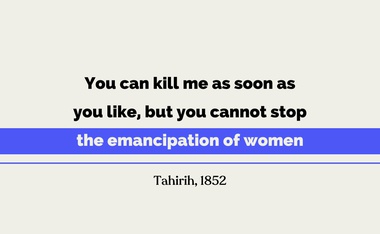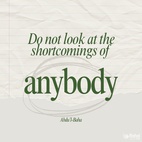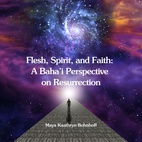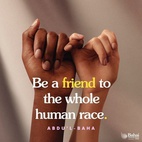The views expressed in our content reflect individual perspectives and do not represent the authoritative views of the Baha'i Faith.
A while ago, a Facebook friend of mine posted a picture of herself wearing hijab – the headscarf covering a woman’s hair – and wrote “Wearing my hijab with pride.”
Which made me wonder “What does pride have to do with wearing a hijab?”
If it is a source of pride, then why is it forced on women in some countries like Iran or Afghanistan, which legally require women to veil themselves? Why was Mahsa Amini, a 22-year-old Kurdish woman, recently fatally beaten by Iran’s morality police for violating that country’s strict hijab law?
Also, because women veil or cover their hair in diverse cultures – some Christian nuns in certain orders, or Orthodox Jewish women in many places, or Hindu women in India – what do such coverings signify, and why are they traditionally worn?
I decided to see if I could find out.
First of all, for Baha’is, a woman taking off the veil and showing her hair and especially her face has a symbolic, significant meaning in the history of the Baha’i Faith – and in the overall history of the emancipation of women.
Tahirih’s Bold Declaration of Women’s Emancipation
In 1848, Tahirih, the first female believer in the new Baha’i dispensation – who was also well-known in Persian society as a courageous poet and intellectual – unveiled herself in a large gathering of men. This unprecedented act shocked the entire culture, especially at a time when women had to be fully covered, because it stood for the strong Baha’i principle of the full equality and emancipation of women. This brief description of that revolutionary act, from Shoghi Effendi’s God Passes By, gives a glimpse of its meaning:
One day in [Baha’u’llah’s] presence … Tahirih, regarded as the fair and spotless emblem of chastity … appeared suddenly, adorned yet unveiled, before the assembled companions … tearing through her fiery words the veils guarding the sanctity of the ordinances of Islam, sounded the clarion-call, and proclaimed the inauguration, of a new Dispensation. The effect was electric and instantaneous. …
Undeterred, unruffled, exultant with joy, Tahirih arose, and, without the least premeditation … delivered a fervid and eloquent appeal to the remnant of the assembly … Thereupon, she invited them to embrace each other and celebrate so great an occasion.
Tahirih’s courageous act of emancipation scandalized many men at the time – and ultimately culminated in her officially-sanctioned murder four years later – but it also marked the beginning of freedom and equal rights for women in the East, and set the principle of gender equality into motion in the Baha’i dispensation. At almost exactly the same moment, in July of 1848 in the United States, the first women’s rights convention took place at Seneca Falls, New York, sponsored by Quakers and spearheaded by Lucretia Mott, Elizabeth Cady Stanton, and Frederick Douglass. All around the world, the Baha’i principle of gender equality began to unfold.
Abdu’l-Baha, in a 1912 address to women’s clubs in Chicago, explained the Baha’i spiritual principle of the equality of the sexes:
When we consider the kingdoms of existence below man, we find no distinction or estimate of superiority and inferiority between male and female. Among the myriad organisms of the vegetable and animal kingdoms sex exists, but there is no differentiation whatever as to relative importance and value in the equation of life. … Inasmuch as we find no ground for distinction or superiority according to the creative wisdom in the lower kingdoms, is it logical or becoming of man to make such distinction in regard to himself? The male of the animal kingdom does not glory in its being male and superior to the female. In fact, equality exists and is recognized. Why should man, a higher and more intelligent creature, deny and deprive himself of this equality the animals enjoy? …
To accept and observe a distinction which God has not intended in creation is ignorance and superstition. The fact which is to be considered, however, is that woman, having formerly been deprived, must now be allowed equal opportunities with man … Until the reality of equality between man and woman is fully established and attained, the highest social development of mankind is not possible.
Today I understand the significance of Tahirih’s unveiling even more, because I see that the original recommendation of wearing a hijab or a veil as a sign of modesty is being misused and made compulsory as a means of the oppression of women in many countries. How did this cultural tradition begin, I wondered?
The Origin of the Veil
There are different levels and types of hijab. Some woman just loosely cover their head with a scarf so their hair is still visible, while others cover all their hair with the traditional hijab. Other women not only cover their hair but also their bodies. In even more extreme cases they can only show their eyes, or in some places like Afghanistan women have to cover their entire selves by wearing a burka.
Many believe these coverings for females began in Islam, but that’s not true. In fact, historians point out that the custom existed long before Muhammad, and was practiced as far back as 2500 BC. Wikipedia says: “Elite women in ancient Mesopotamia and in the Byzantine, Greek, and Persian empires wore the veil as a sign of respectability and high status.”
The Bible, in 1 Corinthians 11, verses 4-7, says “Every woman who prays or prophesies with her head uncovered dishonors her head.”
At the birth of Islam, Muhammad did ask the female members of his household to protect themselves from the gaze of strangers – but the Arabic word hijab can mean either veil, partition, or curtain, as this verse (Sura 33:53) from the Qur’an indicates: “And when you ask [Muhammad’s wives] for something, ask them from behind a partition. That is purer for your hearts and their hearts.” Many contemporary Islamic scholars say that this prescription applied only to the women in Muhammad’s family, not to every Muslim woman.
Indeed, I discovered, the practice of wearing these coverings did not originate in any religion – it is actually a cultural artifact, one likely originally intended to signal ownership of a woman by a man.
So if Muslim women choose to wear hijab to show their modesty, and to retain their privacy from being molested and harassed by men, then don’t Muslim men have a similar responsibility? Although in the Baha’i Faith modesty is also recommended, Baha’i women are not required to wear a hijab, veil, headscarf, or wig. If they choose to do so because of their society’s expectations, that’s up to them.
Certainly Tahirih’s example, almost two centuries ago, indicated a clear break from those cultural, religious, and societal expectations. Because a woman covering herself can symbolize subjugation, Baha’is reject the cultural norms that treat women as somehow inferior or second-class citizens. Abdu’l-Baha wrote:
… among the teachings of Baha’u’llah is the equality of women and men. The world of humanity has two wings – one is women and the other men. Not until both wings are equally developed can the bird fly. Should one wing remain weak, flight is impossible. Not until the world of women becomes equal to the world of men in the acquisition of virtues and perfections, can success and prosperity be attained as they ought to be.
Sadly, the extreme forms of the compulsory covering of women also strongly correlates with their oppression – because in the cultures where women must be veiled they are often forbidden to get an education, are married off at a young age, mostly without their consent, and typically have few rights and little or no personal freedom. In many of those cultures women are expected or even legally required to be submissive to men. Equally importantly, when a woman is forced to cover her face it means she as no identity in society, since our face is what identifies us – and without an identity we do not exist or have any rights.
However, many argue that women in westernized cultures are oppressed in a different way by means of sexual exploitation and the extreme importance given to outward attractiveness and physical beauty.
So, where can we find the solution? The Baha’i teachings ask everyone to avoid harmful extremes by adhering to the spiritual principle of moderation:
A good character is in the sight of God and His chosen ones and the possessors of insight, the most excellent and praiseworthy of all things, but always on condition that its center of emanation should be reason and knowledge and its base should be true moderation.
The Baha’i teachings also say that we live in an age of maturity, and therefore allow everyone to decide for themselves what to wear without being judged, harassed, punished, or scolded. Baha’u’llah, in his Most Holy Book, wrote that “The Lord hath relieved you, as a bounty on His part, of the restrictions that formerly applied to clothing …”
In this day, what matters is not our clothing, but our conduct, purity of thought, and action.
















Comments
Sign in or create an account
Continue with Googleor